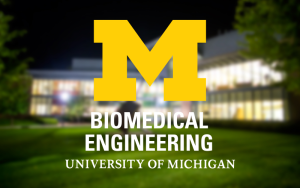Presented By: Biomedical Engineering
A Multicellular, Biomaterial-based Platform for the Engineering of Vascularized Bone
BME PhD Defense: Nicholas Schott

Cell-based tissue engineering offers the potential to greatly improve the treatment of large and complex bone defects by addressing the main shortcomings associated with current bone grafting procedures. A main challenge is the ischemic environment that can result from traumatic bone injury, resulting in the death of transplanted cells and tissue constructs. Achieving an adequate vascular supply is a critical barrier preventing the translational success of cell-based regeneration approaches. Therefore, a variety of strategies have been developed to prevascularize engineered tissue constructs prior to transplantation. Adult mesenchymal stromal cells (MSC) and endothelial cells (EC) are key players in native orthopaedic tissue regeneration and vascularization, and represent promising cell types for tissue engineering strategies to create vascularized bone. However, to effectively harness the regenerative potential of MSC, the appropriate phenotype must be achieved before implantation. A main challenge in engineering vascularized bone tissue is creating an appropriate culture environment to support multiple cell phenotypes. Therefore, this work focuses on designing a cell-based, biomaterial-enabled strategy that provides spatiotemporal control of key microenvironmental cues to support the co-development of osseous and vascular tissues, with the end goal of generating vascularized, bone-forming constructs.
First, this thesis explores how temporal control of the culture environment can be used to maintain preformed vessels and subsequent osteogenic development in engineered tissue constructs. To mimic the sequential process of native bone development, in which vascularization precedes tissue ossification, we generated cell-laden hydrogel constructs cultured in vasculogenic growth medium to induce vessel development, and subsequently supplemented the medium with osteoinductive components to promote osteogenic differentiation. Our results revealed conflicting effects of the two culture environments, in which osteoinductive factors compromised cellular viability and MSC pericyte-like function, leading to ~93% regression of preformed vessels. Further, vasculogenic culture conditions inhibited MSC-mediated matrix mineralization as evidenced by impaired calcium deposition.
Next, this thesis describes the development and characterization of a modular biomaterial approach that provides control of discrete environmental properties designed to promote vasculogenic and osteogenic tissue development. Separate populations of cell-laden microtissues were fabricated and independently cultured under specific differentiation conditions to support either osteogenic or pericyte-like lineage commitment of MSC. This approach enabled the formation of primitive osteogenic microtissues exhibiting mineralization of the extracellular matrix, and vascular microtissues with demonstrated EC sprouting potential. The combination of microtissues led to the generation of a multiphase construct that supported extensive vessel development. While osteogenic activity was maintained without exogenous osteoinductive factors, the vasculogenic culture environment was not conducive for sustained mineralization.
Lastly, this thesis describes a novel approach incorporating the modular biomaterial platform with a biomimetic induction process emulating the native endochondral ossification (EO) pathway to better couple vascular and osteogenic tissue development. Chondrogenically-primed MSC were matured to hypertrophy to form hypertrophic pellets resembling EO, as evidenced by MMP-mediated remodeling and mineralization of the formed cartilaginous matrix. Hypertrophic induction of MSC was associated with secretion of distinct angiogenic factors which stimulated EC vasculogenesis. When combined with vasculogenic microtissues, hypertrophic pellets supported robust vessel development and cell-mediated mineralization without exogenous vasculogenic medium or osteoinductive components.
Overall, this dissertation presents an attractive strategy for generating vascularized bone-like tissue. By integrating the modular biomaterial platform with an EO-based induction process, we successfully leveraged physiologic cues of hypertrophic MSC to achieve concomitant vasculogenic and osteogenic development.
Date: Monday, May 9, 2022
Time: 11:00 AM
Location: 1130 LBME and Zoom (https://umich.zoom.us/j/96133803682 Passcode: bones)
Chair: Dr. Jan Stegemann
First, this thesis explores how temporal control of the culture environment can be used to maintain preformed vessels and subsequent osteogenic development in engineered tissue constructs. To mimic the sequential process of native bone development, in which vascularization precedes tissue ossification, we generated cell-laden hydrogel constructs cultured in vasculogenic growth medium to induce vessel development, and subsequently supplemented the medium with osteoinductive components to promote osteogenic differentiation. Our results revealed conflicting effects of the two culture environments, in which osteoinductive factors compromised cellular viability and MSC pericyte-like function, leading to ~93% regression of preformed vessels. Further, vasculogenic culture conditions inhibited MSC-mediated matrix mineralization as evidenced by impaired calcium deposition.
Next, this thesis describes the development and characterization of a modular biomaterial approach that provides control of discrete environmental properties designed to promote vasculogenic and osteogenic tissue development. Separate populations of cell-laden microtissues were fabricated and independently cultured under specific differentiation conditions to support either osteogenic or pericyte-like lineage commitment of MSC. This approach enabled the formation of primitive osteogenic microtissues exhibiting mineralization of the extracellular matrix, and vascular microtissues with demonstrated EC sprouting potential. The combination of microtissues led to the generation of a multiphase construct that supported extensive vessel development. While osteogenic activity was maintained without exogenous osteoinductive factors, the vasculogenic culture environment was not conducive for sustained mineralization.
Lastly, this thesis describes a novel approach incorporating the modular biomaterial platform with a biomimetic induction process emulating the native endochondral ossification (EO) pathway to better couple vascular and osteogenic tissue development. Chondrogenically-primed MSC were matured to hypertrophy to form hypertrophic pellets resembling EO, as evidenced by MMP-mediated remodeling and mineralization of the formed cartilaginous matrix. Hypertrophic induction of MSC was associated with secretion of distinct angiogenic factors which stimulated EC vasculogenesis. When combined with vasculogenic microtissues, hypertrophic pellets supported robust vessel development and cell-mediated mineralization without exogenous vasculogenic medium or osteoinductive components.
Overall, this dissertation presents an attractive strategy for generating vascularized bone-like tissue. By integrating the modular biomaterial platform with an EO-based induction process, we successfully leveraged physiologic cues of hypertrophic MSC to achieve concomitant vasculogenic and osteogenic development.
Date: Monday, May 9, 2022
Time: 11:00 AM
Location: 1130 LBME and Zoom (https://umich.zoom.us/j/96133803682 Passcode: bones)
Chair: Dr. Jan Stegemann